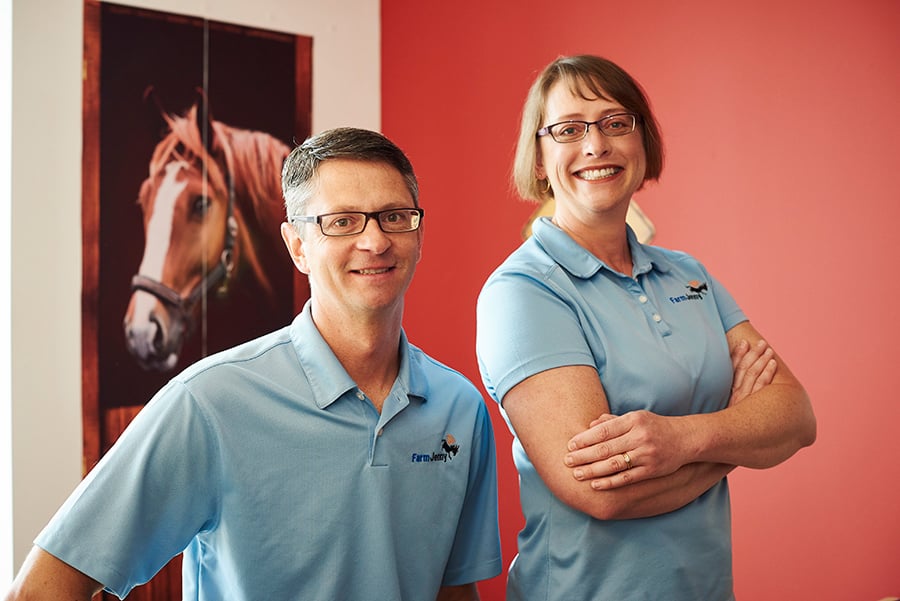Back to articles
Farm Jenny: Multiprotocol Horse Monitoring

The benefits of agricultural IoT aren’t limited to farmers at-scale. We speak to the founders of a startup targeting small and medium farmers with a solution that approaches herd tracking in a unique way.
We’ve written before about advances in agricultural IoT but many of the solutions are only cost-efficient for large farms. Hiring a technology integrator to build an advanced system is simply out of reach for the average small- to mid-size farmer.
This is where the Pittsburgh-based startup Farm Jenny steps in. The equine monitoring platform employs multiprotocol Nordic solutions to track the health and location of farm animals.
Designed primarily for farms and ranches, the solution comprises a network of wearable sensors, field receivers, beacons, and a gateway, connected with Bluetooth Low Energy and Thread. A smartphone app enables the owners to keep track of the animals’ locations and monitor activities that are indicative of health.
We talk to Farm Jenny founders Tammy and Rob Crouthamel about their solution, which uses Nordic’s nRF52840 and nRF52832 SoCs to enable concurrent Bluetooth LE and Thread connectivity.

Where did the idea come from?
Tammy: It’s a problem that we’ve long experienced on our farms because we are away from them during the day working other jobs. Because we’re not at the farm 24/7, we can’t always catch the early behavioural signs of medical issues that animals exhibit.
Like most small farmers, we rely on recollection or journaling of our animal’s unique patterns of behaviour, but our recollections are imperfect and our observations are sporadic.
If we could have known when a horse wasn’t hanging out with his pasture mate on a sunny afternoon, or when a cow soon to calve has separated herself from the herd, we could have caught problems much earlier.
With the combination of our experience on the farm, our network of friends and colleagues in the industry who have similar issues, and our professional experience in wearable electronics and analytics, we decided to do something about it.
How did you design and build the first product?
Robert: We used rapid prototyping to get something working as soon as possible. For our first generation product, we used a Nordic nRF52840 development kit in a plastic enclosure that we strapped to fence posts around the farm.
We started with an example from nRF5 SDK for Thread and Zigbee, a software development kit (SDK) provided by Nordic. The example connects Thread nodes to the cloud, and used TheThings.io to handle the cloud part of the prototype. The SDK has multiple examples for running Thread and Bluetooth LE concurrently.
How did you make the decision to use a Thread/Cellular hybrid model?
Tammy: During the rapid prototyping phase, it quickly became clear that our initial ideas about connectivity would not scale. We had planned for a Thread-based mesh network that would connect to the internet via a Wi-Fi router in a barn.
Unfortunately, relying on Wi-Fi was just not feasible. It surprised us how few of our potential customers knew much about what sort of Wi-Fi service they had, and how it might be possible to extend that to a barn. Cellular took away that problem, increased signal reliability, and provides a seamless setup experience.
How is the cellular connectivity in rural America?
Tammy: It varies a lot by carrier and location, of course. However, most farmers are able to get a good signal somewhere high on the farm, such as a barn roof or at the top of a hill. Our network topology design means the cellular gateway can be installed anywhere on the farm to take advantage of the area with the best signal. The Thread mesh repeaters extend our coverage across the entire property. In addition, we are currently using roaming SIMs. It does cost us a little more, but increases the options for our customers.
Read more: Nordic Goes Cellular: Introducing the nRF91 Series
How do you use beacons as part of the solution?
Robert: The location of an animal is an important behavioural cue as they are so habit-based. Bluetooth Low Energy beacons provide us with pinpoint location data, so we can use it to find out which horses are eating or drinking, for example.
When horses are out in pasture, we use trilateration based on RSSI that gives us accuracy of around 10 meters. In this part of the field we can get by with more broad information to establish associations. That being said, we are looking forward to using the direction finding capability of Bluetooth 5.1 in the future. This should allow us to place our receivers much further apart for the same location accuracy. That means the same performance at a lower cost for our customers.
Why did you choose Nordic?
Robert: I have worked with Nordic devices for many years. At the time we designed this solution Nordic were one of the few suppliers who could support concurrent multiprotocol with Thread and Bluetooth LE. This was crucial for us as it meant we could develop our field receiver with a single wireless system-on-chip (SoC), resulting in only one FCC radio approval process.
All of our projects start with an SDK example and we rely on the regular cadence of SDK releases from Nordic to continue to stay on top of things. Because Nordic is a key player in the Bluetooth SIG, we know we’ll get an SDK release that supports the latest and greatest features. That’s important because we are using Bluetooth LE and Thread in an unconventional way, so we need to access all the capabilities.
Find out more information about Farm Jenny here.


